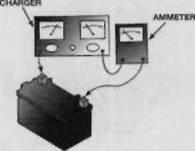
CATEGORIES:
BiologyChemistryConstructionCultureEcologyEconomyElectronicsFinanceGeographyHistoryInformaticsLawMathematicsMechanicsMedicineOtherPedagogyPhilosophyPhysicsPolicyPsychologySociologySportTourism
Inspection and maintenance
6 The battery fitted to the models covered in this manual is of the maintenance free (sealed) type and therefore does not require topping up. However, the following checks should still be regularly performed.
7 Check the battery terminals and leads for tightness and corrosion. If corrosion is evident, unscrew the terminal screws and disconnect the leads from the battery, disconnecting the negative (-ve) terminal first. Wash the terminals and lead ends in a solution of baking soda and hot water and dry them thoroughly. If necessary, further clean the terminals and lead ends with a wire brush, knife or wire wool. Reconnect the leads, connecting the positive (+ve) terminal first, and apply a thin coat of petroleum jelly to the connections to slow further corrosion.
8 The battery case should be kept clean to prevent current leakage, which can discharge the battery over a period of time (especially when it sits unused). Wash the outside of the case with a solution of baking soda and water. Rinse the battery thoroughly, then dry it.
9 Look for cracks in the case and renew the battery if any are found. If acid has been spilled on the frame or battery box, neutralise it with a baking soda and water solution, dry it thoroughly, then touch up any damaged paint.
10If the motorcycle sits unused for long periods of time, disconnect the battery negative (-ve) terminal. Honda recommend that the battery is recharged once every two weeks when the motorcycle is not being used (see Section 4).
11 The condition of the battery can be assessed by measuring the voltage present at the battery terminals with a multimeter. Connect the multimeter positive (+ve) probe to the battery positive (+ve) terminal, and the negative (-ve) probe to the battery negative (-ve) terminal. When fully charged there should be more than 13 volts present. If the voltage falls to 12.3 volts the battery must be removed, disconnecting the negative (-ve) terminal first, and recharged (see Section 4).
4 Battery- charging §$>
Caution: Be extremely careful when handling or working around the battery. The electrolyte is very caustic and an explosive gas (hydrogen) is given off when the battery is charging.
1 Ensure the charger is suitable for charging a 12V battery.
2 Remove the battery from the motorcycle (see Section 3). Connect the charger to the battery BEFOREswitching the charger ON. Make sure that the positive (+ve) lead on the charger is connected to the positive (+ve) terminal on the battery, and the negative (-ve) lead is connected to the negative (-ve) terminal.
3 Few owners will haveaccess toan expensive current controlled charger, so if a normal domestic charger is used check that after a possible initial peak, the charge rate falls to a safe level (see illustration).If thebattery becomes hot during charging STOP.Further charging will cause damage. Note: In emergencies the battery can be charged at a high rate of around 4.0 amps for a period of 1 hour. However, this is not recommended and the low amp (trickle) charge is by far the safer method of charging the battery.
4 If the recharged battery discharges rapidly when left disconnected, it is likely that an

Date: 2016-01-14; view: 676
| <== previous page | | | next page ==> |
| General information | | | A blown fuse can be identified by a break in its element |